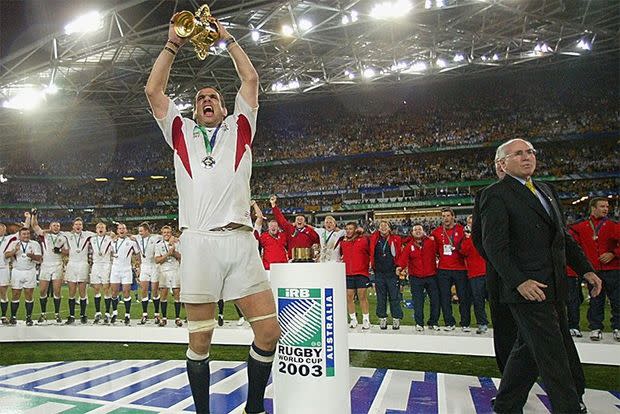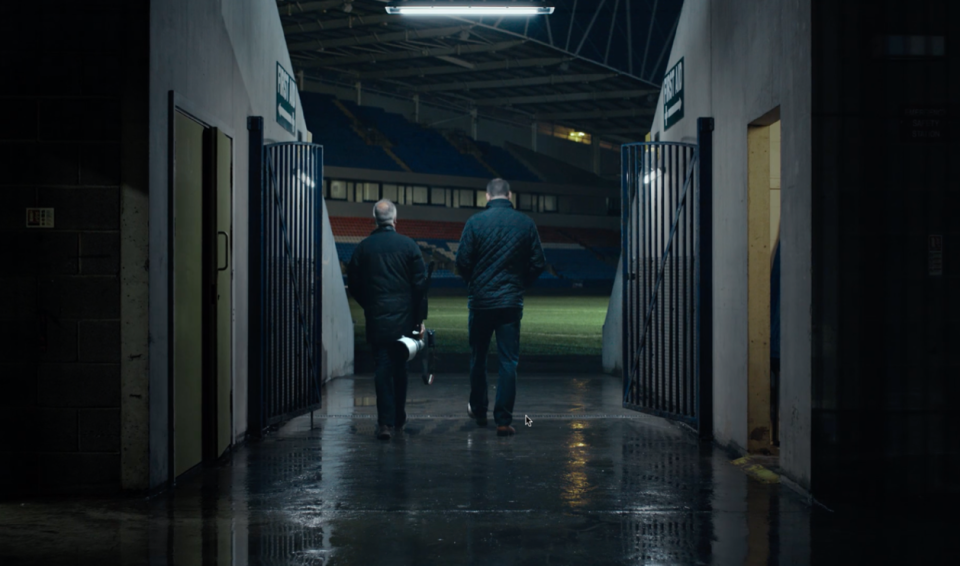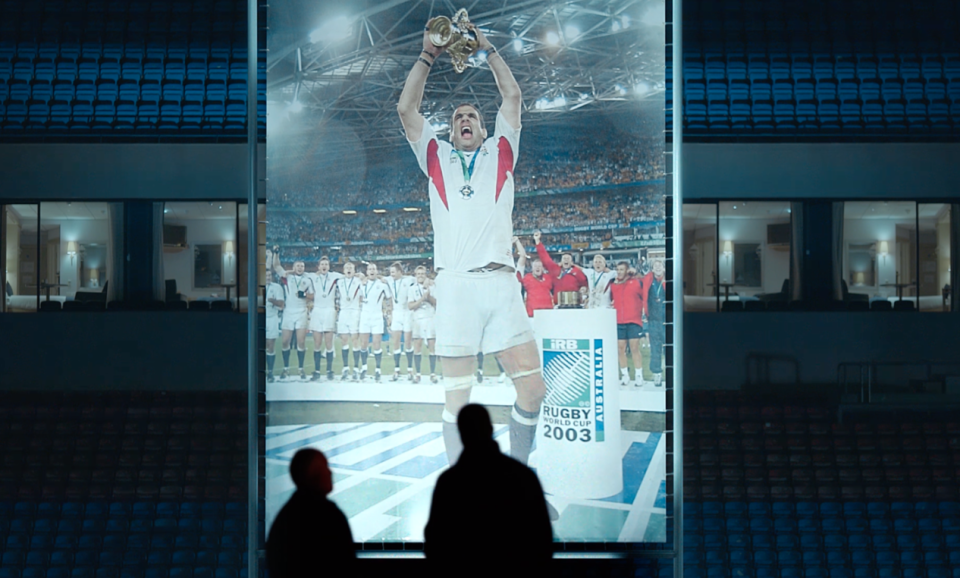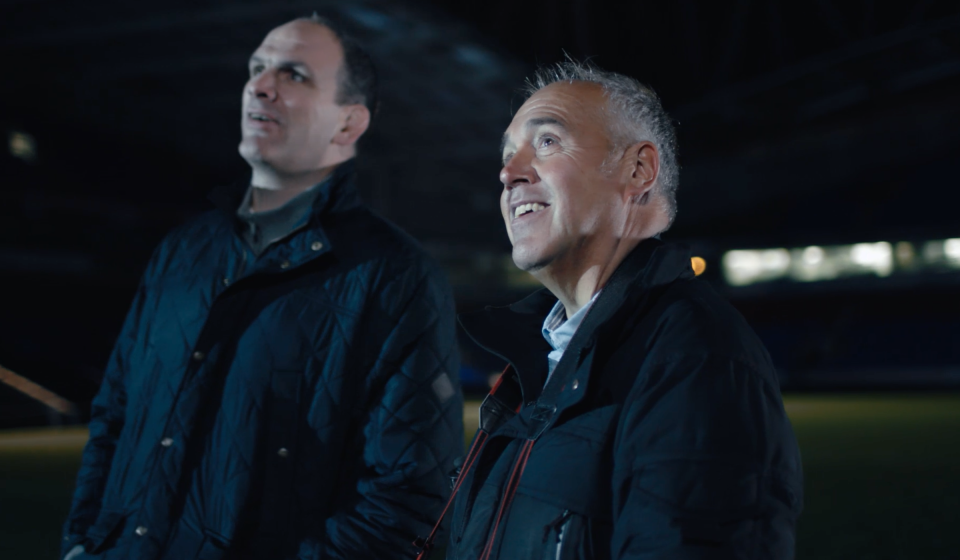Dream shot: the story behind an iconic rugby photo

On a wet November night in 2003 a big man lifts a trophy and roars. In the background, teammates celebrate below the yellow glow of stadium lights. Rain falls from the dark Sydney skies.
When Martin Johnson lifted the Webb Ellis Cup and claimed England’s first Rugby World Cup, one of the nearest men to him was neither teammate nor tournament official. Photographer Dave Rogers, kneeling on the damp floor three metres away, lifted his camera and clicked. The moment he captured - and the photo that captured it - have gone down in English sporting history.
Not that Dave was thinking about history back then. He was the only photographer granted close-up access to the podium. He would capture the moment in all its most intimate glory - or nobody would. He was, understandably, terrified.
“All the rest of the guys were about ten metres behind me standing up,” he tells Martin, when the two meet again nearly 16 years later, on the verge of another World Cup. “I was the only one allowed to go on the pitch next to you. I was very privileged, but it was so, so nerve wracking.”

Martin sums up the situation nicely: “Imagine if we’d won and you’d blown the photo!”
Dave needn’t have worried. Soon the resulting shot would flash around the globe. The image quickly became the iconic record of an iconic moment.
The picture is raw, unfiltered and perfect. Raindrops fleck the edge of the frame, and the Webb Ellis Cup looks almost toylike in the big captain’s hands, its base thrust towards the cheering crowds. “The former captains who’ve lifted the trophy gave me grief afterwards,” says Martin. “You should lift it straight, holding it by the handles. But I’ve got it up so you can see the bottom of it!”

Martin’s impressive stature is emphasised by Dave’s kneeling position, the perspective letting the triumphant captain fill the centre of the frame. Raindrops seem to create a halo around the scene. “Luckily, I’d just wiped a lot of it off (the lens), but you still get the atmosphere with the rain there,” says Dave.

The result is a captured moment of unscripted joy, an outpouring of natural, instinctive emotion. It’s real and human, as the best sports photography so often is.
How to capture sporting moments
Dave shares his expert advice on shooting great sporting pictures, whatever the sport.
1. Know your sport
It doesn’t matter the sport, the best shots are taken by people who know the game. “Learn the rules of the game, so you know what players are trying to do,” says Dave. Know your sport and you’ll know where to be, what to look out for, and what might happen next.
2. Sit in the sun
If you have a choice, sit in the sunshine and shoot into the shady side of the pitch. It will make your pictures backlit. Shoot into the sun, says Dave, and “quite often you just get a silhouette of a player against the bright background. So always sit in the sunny side. You'll get nicer colours that way too.”
3. Go low
Dave captured the drama of Martin Johnson lifting the World Cup from a kneeling position, and he advises going low to get a perfect action shot: “Lower your angle. If you get down low when a player dives towards you, it looks as if they're flying through the air.”
4. Buy the best kit you can
If that’s the camera on your phone, so be it. If you have some budget, Dave says “ease of use, reliability and value for money” are the criteria to look out for.
For beginners, the Canon PowerShot SX70 HS is the perfect camera for sports photography. Its 65x optical zoom lets you get close to the action. A shooting speed of 10 frames per second alongside fast, accurate autofocus means you’ll be able to capture every action packed moment of the game.
5. Graduate to DSLR
At some point you’ll want to step up to DSLR, so you can take advantage of Canon’s superb range of lenses. “The standard lens in sports photography is the Canon EF 400mm f/2.8L IS II USM, which is superb,” says Dave.
The 400mm is a specialised piece of kit for professionals. Amateurs will find the Canon EF 70-200mm f/2.8L IS III USM a more useful and cost-effective alternative, and the Canon EF 70-300mm f/4-5.6 IS II USM will let you achieve excellent results on an even tighter budget.
“They are reliable and take a lot of knocks. When you do sports, you're putting the cameras down at speed and running around – they have to be pretty robust to withstand that,” says Dave.
The most defining moments in Rugby World Cup history have been taken on Canon. Discover Canon kit bundles, which have everything you need to capture your own personal sporting stories and historic moments.

 Yahoo Movies
Yahoo Movies 
